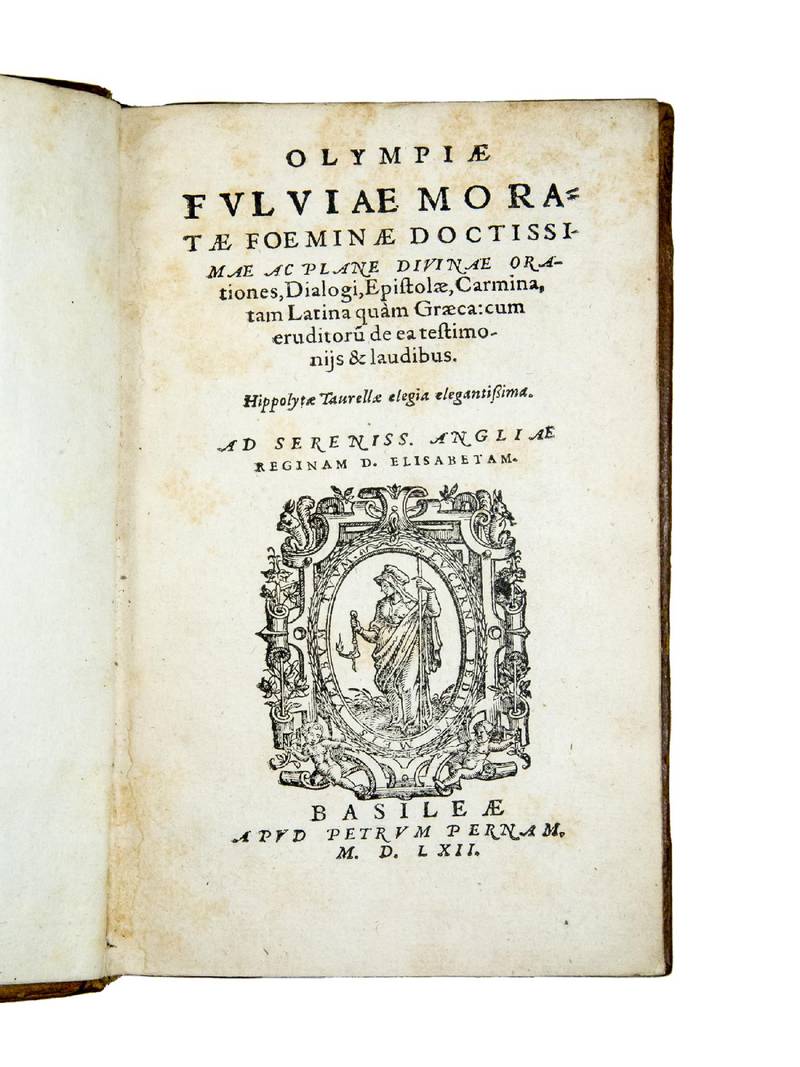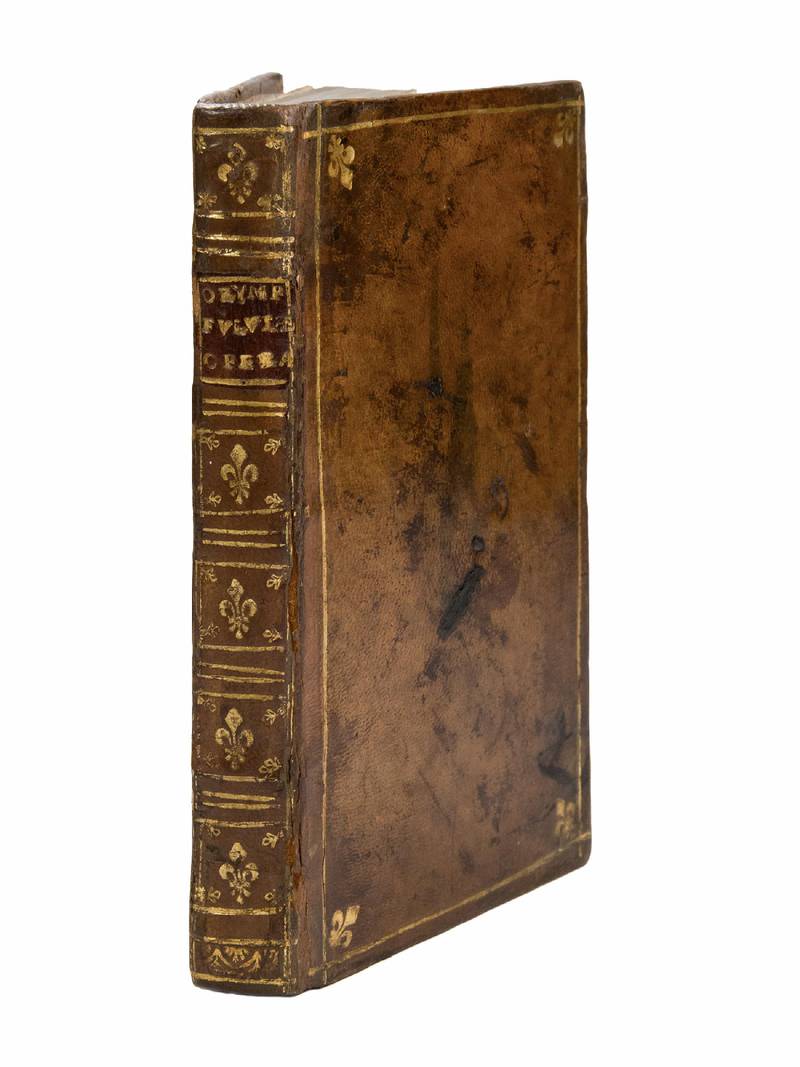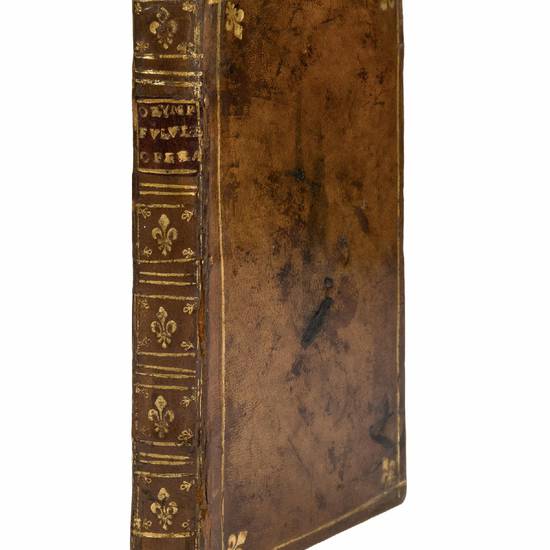8vo. (16), 278 pp., (1) leaf (errata). *8, A-R8, S4. With Morata's epitaph by Johannes Herold within a full-page woodcut border. 18th century calf with gilt fillets and floreal ornaments on the panels, gilt back and edges, marbled endpapers. With the book-plates of the French linguist and book-collector Pierre-Alexandre Gratet-Duplessis (1792-1853) and of the architect Jules-Édouard Potier de la Morandière (1813-1905).
Adams, M-1742; VD 16, M-6287; O. Morata, The Complete Writings of an Italian Heretic, H.N. Parker, ed., (Chicago, IL, 2003), pp. 84-177; D. Pirovano, Le edizioni cinquecentine degli scritti di Olimpia Fulvia Morata, in: “Le varie fila. Studi di letteratura italiana in onore di Emilio Bigi”, (Milano, 1997), pp. 101-102.
SECOND, GREATLY ENLARGED EDITION published by the Italian emigrant scholar Celio Secondo Curione (1503-1569) with a new dedication to Queen Elizabeth of England, dated Basel, September 1, 1562.
The first edition was published in 1558 and contained thirty letters by and to Morata as well as some letters by others. In the present edition the number of letters was raised to 74, of which 50 were by Morata, 14 to her and 10 by others. In the third edition (1570), which was reprinted in 1580, two Italian letters by Morata were added.
The volume contains furthermore a declamation on Cicero's Stoic Paradoxes and another In Praise of Mutius Scaevola (the latter in both Greek and Latin), a Latin translation of the first two stories of Boccaccio's Decameron,two dialogues in Latin, eleven poems (eight in Greek and three in Latin), and the translation into Greek of seven Psalms, as well as several poems in Greek and Latin in her praise and some epitaphs (cf. O.F. Morata, Briefe, R. Kössling, ed., Leipzig, 1990, pp. 215-216).
At the end of the volume is printed the famous letter in form of an elegy variously attributed to Ippolita Torelli (1499-1520), wife of Baldassarre Castiglione, who was one of the most influential representatives of courtly culture in Italy and author of the Courtier (1528). This poem was first included in his Latin poetry as by himself. It was written in 1518, when Baldassarre was ambassador to the Gonzaga at Rome. In it she laments his absence from home and calls his attention to the dangers of the court of Leo X. She mentions as a great comfort the portrait Raphael had painted of him. Added is also her epitaph by Pietro Bembo, which is found on her tomb in the Santuario delle Grazie near Mantua (cf. J.D. Falvo, The Economy of Human Relations: Castiglione's ‘Libro del Cortegiano', New York, 1992, pp. 159-166).
“Es ist eine bunte Vielfalt von Begegnungen und Verbindungen zwischen italienischen sowie deutschen und in einem Falle auch schweizerischen Gelehrten, die sich in Olympia Moratas Korrespondenz widerspiegelt. Diese gründete im wesentlichen auf der Gemeinsamkeit Renaissance-humanistischer Bildung und - mehr oder weniger ausgeprägt - auf reformatorischer Glaubenshaltung. Möglicherweise hatte der deutsche Dichter Goethe auch diese Kontakte im Blick, als er unter dem 30. Januar 1828 in seinem Tagebuch notierte: ‘Las in den Briefen der Olympia Fulvia Morata, und es ging mir über den eigentlichen, damaligen, protestantischen Zustand ein ganz neues Licht auf. Meine Bemerkungen denke niederzuschreiben' ” (R. Kössling, Die Korrespondenz der Olympia Fulvia Morata (1526-1555) als Dokument italo-deutscher Begegnungen, in: “Acta Conventus Neo-Latini Bariensis”, Tempe, AZ, 1998, p. 377).
Celio Secondo Curione was born the youngest of twenty three children in Moncalieri in the province of Turin. He first studied law and humanities at Turin and continued his studies in Milan, where he also started to teach in 1528. He became more and more interested in the writings of the German reformers. He taught at Pavia and Venice, where he met Bernardino Ochino. He lived for a short time at the court of Ferrara and in Lucca. After several narrow escapes from the Inquisition he fled to Switzerland via the Grisons where he met with Camillo Renato, an Antitrinitarian, and became rector of the newly founded University of Lausanne in 1542. In 1546 he went to Basel, where he taught ancient classics at the University until his death. He gained a wide reputation and attracted many students coming from foreign countries. He declined invitations by the Pope to Rome, by the Duke of Savoy to Turin, from the Emperor to the University of Vienna, and from the prince of Transylvania to the new college established at Alba Julia. He was not a confessed theologian, nevertheless he wrote a treatise Christianae religionis institutio (1549), from which he omitted any mention of the Trinity or the deity of Christ as a doctrine necessary for salvation. In 1550 he attended the Anabaptist Council at Venice and in 1554 wrote a work dedicated to the Polish king, De amplitudine beati regni Dei, in which he opposed Calvin's doctrine of predestination. He was accused by Vergerio in 1559 of heresy, but was exonerated by the University of Basel. Curione was very careful not to commit himself to any compromising doctrinal position, nevertheless his writings and his association with Castellio, Ochino, and Lelio Sozzini make him one of the precursors of the Unitarian-Socinian movement (cf. M. Kutter, Celio Secondo Curione. Sein Leiben und sein Werk, Basel & Stuttgart, 1955, passim).
(Liber I:)
Sinapius, Kilian (p. 73)
from Morato, Fulvio Pellegrino. Ferrara, June 25, 1540 (p. 74)
Sinapius, Kilian [in Greek] (p.82)
Sinapius, Kilian. Ferrara (p. 85)
Sinapius, Johannes (p. 87)
id. (p. 88)
from Sinapius, Johannes (p. 89)
from Calcagnini, Celio (p. 89)
id. (p. 92)
Grundler, Andreas (p. 94)
Sinapius, Johannes. Ferrara, May 30, 1548 (p. 96)
id. Ferrara, April 12, 1548 (p. 97)
id. Ferrara, June 1, n.y. (p. 98)
id. Ferrara, May 14, 1549 (p. 99)
id. Kaufbeuren, August 25, 1548 (p. 99)
from Della Rovere, Lavinia. Parma, November 2, n.y. (p. 100)
Della Rovere, Lavinia (p. 101)
Orsini, Maddalena (p. 104)
Giraldi, Lilio Gregorio (p. 104)
Curione, Celio Secondo. Augsburg, October 7, n.y. (p. 105)
id. to Betuleius [Birck], Sixtus. Basel, December 25, n.y. (p. 108)
from Curione, Celio Secondo. Basel, September 5, n.y. (p. 111)
Curione, Celio Secondo. Schweinfurt, October 1, n.y. (p. 114)
Della Rovere, Lavinia. Schweinfurt (p. 118)
id. Schweinfurt(p. 121)
Hörmann, Anton (p. 122)
Schleenried, Lorenz. Schweinfurt (p. 123)
Hörmann, [Anton] (p. 124)
Carchesius, Valentin. Schweinfurt (p. 125)
Hörmann, Georg. Würzburg (p. 127)
Lucius, Thomas (p. 128)
Carchesius, Valentin (p. 129)
Hörmann, Anton. Schweinfurt (p. 131)
Hörmann, Georg. Schweinfurt (p. 132)
Weber, Michael. Schweinfurt, November 20, 1552 (p. 133)
Sinapius, Johannes. Schweinfurt, January 15, 1553 (p. 135)
Della Rovere, Lavinia (p. 136)
Flacius Illyricus, Matthias. Schweinfurt, May 26, 1553 (p. 139)
Cuidam Concionatori German (To a German preacher). Schweinfurt (p. 143)
(Liber II:)
Este, Anna d'. Heidelberg, July 1, 1554 (p. 146)
Grundler, Andreas. November 22 (p. 150)
id. (p. 152)
from Sinapius, Johannes (p. 153)
Sinapius, Johannes to Grundler, Andreas. Würzburg, July 25, 1554 (p. 155)
Sinapius, Kilian. Heidelberg, January 25, [1555] (p. 160)
id. Heidelberg (p. 161)
Campanus [Glock], Andreas (p. 163)
id. Heidelberg, January 26, 1555 (p. 165)
from Campanus [Glock], Andreas. January 1555 (p. 166)
from Ruprecht, Wolfgang. Ehrenfriedersdorf, June 25, 1555 (p. 167)
Campanus [Glock], Andreas. Heidelberg, February 2, n.y. (p. 170)
from Rosa, Andreas (p. 171)
from Du Moulin, Charles. Worms, July 14, 1555 (p. 173)
[Vergerio, Pier Paolo] (p. 174)
Infantius, Johannes (p. 176)
Curione, Celio Secondo. Heidelberg, July 25, n.y. (p. 177)
id. (p. 181)
from Curione, Celio Secondo. Basel, September 1, 1554 (p. 181)
Curione, Celio Secondo. Heidelberg, December 1, n.y. (p. 184)
id. Heidelberg, June 5, n.y. (p. 185)
from Curione, Celio Secondo. Basel, August 26, 1555 (p. 186)
Agenosius, Hieronymus [in Greek] (p.189)
from Ageniosius, Hieronymus (p. 190)
Della Rovere, Lavinia. Heidelberg, August 1, n.y. (p. 192)
Morata, Vittoria. Heidelberg, August 8, n.y. (p. 195).
Grundler, Andreas to Curione, Celio Secondo. Heidelberg, November 22, 1555 (p. 203)
Curione, Celio Secondo. Heidelberg (p. 208)
id. to Grundler, Andreas. Basel, March 15, 213 (p. 210)
Curione, Celio Secondo to Morata, Lucrezia. Basel, January 1, 1556 (p. 213)
Campanus [Glock], Andreas to Grundler, Andreas. November 24, 1555 (p. 218)
Sinapius, Kilian to Curione, Celio Secondo. Speyer, July 29, 1560 (p. 219)
Curione, Celio Secondo to Sinapius, Kilian. Basel, September 1, 1560 (p. 221)
id. to Sinapius, Johannes. Basel, September 1, 1560 (p. 223)
Sinapius, Chilian to Curione, Celio Secondo. Speyer, May 15, 1562 (p. 224)
Olympia (or Olimpia) Morata was born in Ferrara, the eldest child of Fulvio Morato, a humanist scholar who was tutor to the younger sons of Alfonso d'Este, duke of Ferrara. She learned her subjects so well that at the age of twelve or thirteen she was invited to the court of Ferrara as a companion of study to Anna d'Este, the daughter of Duke Ercole II and Duchess Renée of France. There she continued her classical studies with Anna under the guidance of her father and two German brothers, Johannes and Kilian Sinapius.
She was considered a “fanciulla prodigio”, and won the praise of many intellectuals for her fluency in Latin and Greek. It is highly probable that her sympathies for the Reformation began at the court of Ferrara since the Duchess herself supported the efforts of the reformers. Also Olympia's father shared these views, and in 1532 was forced to leave Ferrara. For six years the family lived in other northern cities, where Morato lectured on the teachings of Luther and Calvin. In 1547, her father became ill, and Olympia left court to help her mother care for him until his death the following year.
Morata then returned to court, but things had changed there: Anna had left for France to be married to François de Guise, and Ercole had finally succumbed to pressure from Rome to purge the court of religious reformers. In Ferrara, Morata met a young German follower of Luther, Andreas Grundler, who was finishing a medical degree. In late 1549 or early 1550, they married. By the end of 1550, the couple moved to Germany to evade the Roman Inquisition, accompanied by Morata's 8-year-old brother Emilio and settled at Grundler's home in Schweinfurt, in central Germany (Morata's mother and sisters remained in Italy), never to return to Italy.
Grundler accepted a position as medical doctor for the Imperial Spanish troops who were stationed in Schweinfurt. From 1553-54, they were caught in the middle of war. Schweinfurt was occupied by the soldiers of Albert Alciabides, and Morata, Grundler, and Emilio lived in dangerous and difficult conditions, at one point taking refuge in a wine cellar. Ultimately, the city was sacked and burned by Albert's enemies. The Grundler household left the city as refugees, having lost everything, including most of Morata's written work. They went eventually to Heidelberg, where Grundler accepted a position as professor of medicine at the university and Morata tutored students in Greek and Latin.
However, the fever that Morata caught in Schweinfurt never subsided, and a few months later she died. She was not quite 29 years old. Less than two months later, Grundler and Emilio also died, most likely of the plague that had taken hold of the residents of Heidelberg. Although most of Morata's writing had been lost, her friends gathered up all they could find and in 1558 one of them, Celio Curio, published the first edition of her works, along with letters to her from others and laudatory poems; other items were found and added in later editions.
From these, we can hear the voice of a woman trying to balance her humanist ideals with her religious beliefs, and trying both to live in an uncertain world and to help her friends to do the same. For her, learning was not a mere ornament, but her true identity. She also was one of the very first women whose writings were put on the Index. In fact her name is found on the list of prohibited authors of ‘second class' in the Clementine Index of 1596 (cf. A. Rabil, Jr., Olympia Morata, in: “Italian Women Writers: A Bio-bibliographical Sourcebook”, Westport, CT, 1994, pp. 267-279; J. Stevenson, Women Latin Poets: Language, Gender and Authority from Antiquity to the Eighteenth Century, Oxford, 2005, pp. 285-288; and C. Franceschini, ‘Literarum studia nobis communia': Olimpia Morata e la corte di Renata di Francia, in: “Schifanoia”, 28/29, 2005, pp. 207-232).
[9068]




